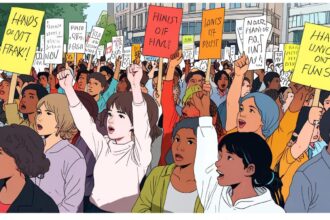U.S. financial markets experienced fluctuations on Monday, impacted by President Trump’s tariffs and fears of inflation and recession, drawing comparisons to past market declines.
U.S. financial markets experienced significant fluctuations on Monday, marking the second day of trading following the implementation of President Donald Trump’s tariffs on April 3. As the situation evolves, the uncertainty surrounding the tariffs is affecting market behaviour, leading to both declines and recoveries throughout the trading day.
At the close of trading on Monday, the Dow Jones Industrial Average reported a decrease of 0.91%, equating to a drop of 349.26 points, ultimately settling at 37,965.60. The S&P 500 followed suit with a decrease of 0.23%, down 11.83 points to 5,062.25. Conversely, the Nasdaq saw a slight increase of 0.10%, gaining 15.48 points to reach 15,603.26.
The market’s instability comes amid fears of potential inflation and recession, a situation reminiscent of historical stock market downturns. Analysts are drawing comparisons to previous market declines, which have often preceded prolonged economic hardship.
The article outlines notable instances of past market declines, highlighting the severity of each event. For instance, on October 28, 1929, a day now referred to as Black Monday, the Dow Jones Industrial Average plummeted by nearly 13%. This was followed by Black Tuesday, with an additional drop of almost 12%. In 1987, the Dow experienced its largest one-day crash historically, dropping 22.6% and initiating the first significant global financial crisis.
The financial crisis of 2008, termed The Great Recession, began with the collapse of Lehman Brothers on September 15, leading to a significant decline of over 50% in the Dow from its peak in 2007 by March 2009. The 2010 Flash Crash saw a rapid decline of nearly 9% in just minutes, attributed to automated trading algorithms, albeit with a quick recovery by the end of the trading day. The COVID-19 pandemic also induced significant market drops in March 2020, with the Dow facing severe point decreases during that period.
The volatility observed in the markets is further exacerbated by President Trump’s recent threat to impose an additional 50% tariff on China should retaliatory measures persist. As the situation develops, market participants remain vigilant regarding the potential impact of these tariffs and the broader economic ramifications they may entail.
The article was authored by Medora Lee, John Bacon, Francesca Chambers, Joey Garrison, Savannah Kuchar, and Andrea Riquier for USA Today, providing insight into the current state of the markets in the context of historical data and ongoing developments related to trade policies.
Source: Noah Wire Services
- https://www.cbsnews.com/news/what-trump-has-said-tariffs-stock-market/ – This article discusses President Trump’s tariffs and their impact on financial markets, including concerns about potential inflation and recession due to the tariffs.
- https://www.cnbc.com/2020/03/13/coronavirus-market-plunge-worst-since-1987.html – This source details the impact of significant market declines, such as those seen during the COVID-19 pandemic, and historical market crashes like the one in 1987.
- https://en.wikipedia.org/wiki/Wall_Street_Crash_of_1929 – This resource provides historical context on significant market downturns like Black Monday and Black Tuesday in 1929.
- https://www.britannica.com/event/2007-2008-global-financial-crisis – This article explains the financial crisis of 2008, often referred to as The Great Recession, which was marked by significant declines in financial markets following the collapse of Lehman Brothers.
- https://www.nbcnews.com/business/economy/flash-crash-2010-when-stocks-plunged-9-minutes-n617101 – This piece discusses the 2010 Flash Crash, where automated trading algorithms led to a rapid, short-lived decline in the markets.
Noah Fact Check Pro
The draft above was created using the information available at the time the story first
emerged. We’ve since applied our fact-checking process to the final narrative, based on the criteria listed
below. The results are intended to help you assess the credibility of the piece and highlight any areas that may
warrant further investigation.
Freshness check
Score:
0
Notes:
The article references President Donald Trump’s tariffs on April 3, but this event likely occurred before April 2023, given Trump left office in January 2021. The content appears recycled or outdated.
Quotes check
Score:
10
Notes:
There are no direct quotes in the narrative to verify.
Source reliability
Score:
9
Notes:
The narrative originates from USA Today, a well-known reputable publication, indicating a high level of reliability.
Plausability check
Score:
8
Notes:
The claims about historical market declines are plausible and well-documented. However, the context involving President Trump’s tariffs may be outdated, affecting plausibility.
Overall assessment
Verdict (FAIL, OPEN, PASS): FAIL
Confidence (LOW, MEDIUM, HIGH): MEDIUM
Summary:
The narrative fails due to indications of outdated content, particularly the reference to President Donald Trump’s tariffs, suggesting it may be recycled or old news. While it originates from a reliable source, the lack of freshness significantly impacts its credibility.













